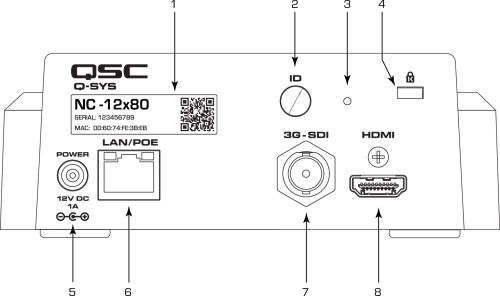NC Series Models
The NC Series comprises the three camera models: the NC-110 ePTZ camera, and the NC-12x80 and NC-20x60 PTZ cameras.
Note: For more NC Series camera information, including features, Q-SYS Designer Software components, and specifications, see the NC Series Conference Cameras topic in the Q-SYS Hardware section. For installation instructions, see the Hardware User Manual on the NC Series product page.
NC-110 ePTZ
The NC -110 is an ePTZ camera that uses electronic pan, tilt and zoom. Unlike the QSC PTZ-IP cameras, this model does not have motors that adjust the image. Instead, the camera’s processor adjusts and crops the image as necessary to deliver the desired result. For example, in this image, the total field-of-view is cropped digitally and then made to look larger, giving the appearance of having been zoomed in:

Front Panel (NC-110 ePTZ)

-
LED: The NC-110 features a single power and status LED that provides feedback on device state.
-
Blinking Green: Power is on and camera is in ID Mode
-
Solid Blue: Power is on and the camera is not streaming
-
Solid Green: Power is on and the camera is actively streaming
-
Off: Camera is in Privacy Mode (if the camera is powered) or no power is detected
-
-
Included Camera Mount: This product can be configured for monitor-mounting or surface-mounting.
-
Surface Mounting Screw Holes
-
Universal Mounting Adapter: This can be used when connecting the NC-110 to a different mount.
Rear Panel (NC-110 ePTZ)

-
Factory Reset Pinhole: Use a paperclip or similarly sized object to insert. Press and hold the reset button for 5 seconds. This resets all parameters to the factory defaults.
-
ID Button: Press to identify this product in Q-SYS Designer and Configurator. The STATUS LED on the front panel blinks green when in ID mode. Press again to turn off.
-
LAN/PoE: RJ-45 connector for Q-SYS Gigabit Ethernet and Power over Ethernet. Cat5e cabling or better required.
NC-12x80 and NC-20x60 PTZ
The NC Series PTZ cameras use mechanical motors to adjust the positioning of the lens left and right (pan), up and down (tilt) and in and out (zoom). The NC-12x80 is a 12x optical zoom camera with a 4K image sensor and an 80° horizontal field of view lens. The NC-20x60 is a 20x optical zoom camera with a 4K image sensor and a 60° horizontal field of view.
Front Panel – NC-12x80 and NC-20x60 PTZ

-
Status LED (Green)
-
Off indicates the camera is in standby mode; network streams are off.
-
On indicates the camera is streaming video over the network.
-
Blinking indicates the ID mode is on.
-
-
Power LED (Blue)
-
On indicates the camera has power applied.
-
Off indicates the camera has no power applied.
-
Rear Panel – NC-12x80 and NC-20x60 PTZ

-
Product Label
-
Identifies product model: NC-12x80 or NC-20x60
-
Identifies the product serial number
-
Identifies the product MAC address
-
-
ID Button: Press to identify this product in Q-SYS Designer Software and Q-SYS Configurator. The green STATUS LED on the front panel blinks when in ID mode. Press again to turn off.
-
Factory Reset pin-hole: Use a paperclip or similarly sized object to insert. Press and hold the reset button for 5 seconds. This resets all parameters to the factory defaults.
-
Kensington™ Lock Slot: for use with a security cable (not supplied).
-
DC 12 V: Connect an external power supply (not included). Supply must be rated at 12VDC 1A, EIAJ-04, center pin positive, outside barrel negative. Use only a class 2/LPS power supply.
-
LAN/PoE: RJ-45 connector for Q-SYS Gigabit Ethernet and Power over Ethernet. Cat5e cabling or better required.
-
3G-SDI: 3G-SDI output via various video formats. Video formats can be changed via Q-SYS Designer Software or a Q-SYS User Control Interface (UCI). Maximum video format is 1080p60.
-
HDMI: HDMI® 1.4b output via various video formats. Video formats can be changed via Q-SYS Designer Software or a Q-SYS UCI. Maximum video format is 4K30.
Note: NC Series PTZ cameras support the usage of either HDMI or SDI, but not both simultaneously.
